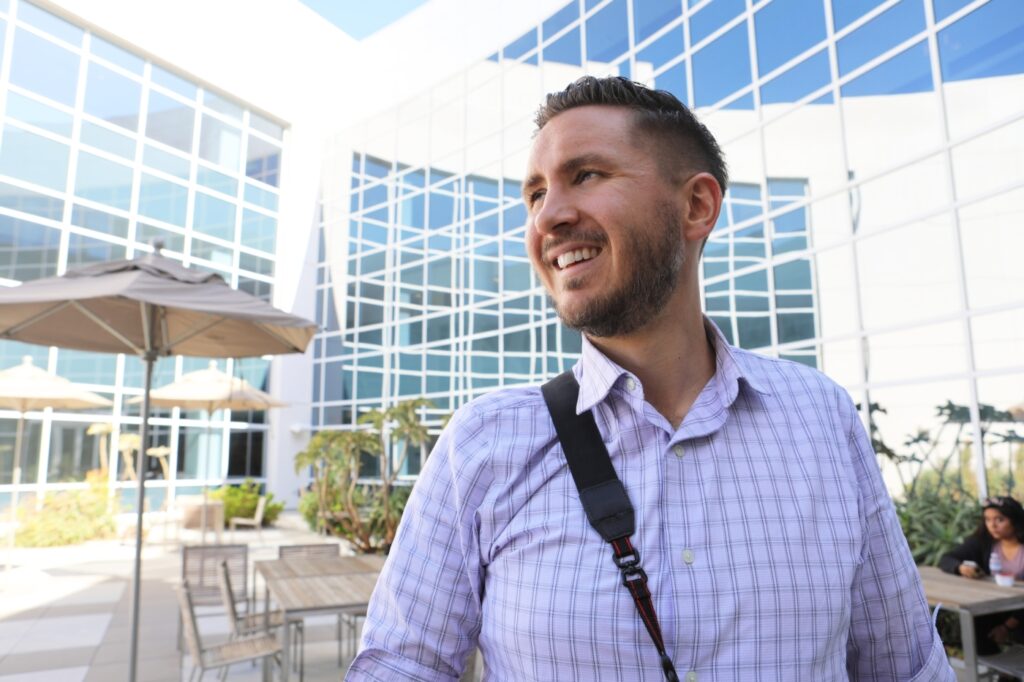
With nearly 50,000 people on campus and an infinite number of stories to tell, Matt Gush, Cal State Fullerton’s assistant director of digital media & university photographer, couldn’t ask for a more fascinating job.
Tasked with illustrating all of the university’s happenings, the Titan alumnus can be seen with his camera documenting everything from a corpse flower in bloom at the Fullerton Arboretum to Homecoming festivities and computer science students developing robotic prosthetic limbs.
“One of the reasons I adore my role is that every day I get to do something different,” Gush said.
But Gush and his shutter skills have captured far more than just slices of college life. His passion for anthropology landed one of his photographs in a recent print issue of National Geographic, an accomplishment he still has a hard time wrapping his head around.
“It’s really weird when you’re out chasing your dreams one day, and then you get an email from National Geographic,” Gush said.
That dream began for Gush as a high school student. The Whittier native dabbled in drawing and painting with plans to become an illustrator, but that all changed when his father brought home a digital camera. The immediate gratification that came from taking a photo and being able to instantly view it had him hooked.
“I found the right medium, and ever since that day, my life forever changed because I couldn’t get enough of it,” Gush said. “I switched over from painting into photography and never looked back.”
Gush came to CSUF with plans to complete a number of general education requirements before diving into his art classes. It was there that he discovered anthropology and archeology, fields of discipline that sparked a previously untapped interest.
“I had never been exposed to studying humans and civilization as an actual area of scholastic inquiry,” Gush said.
Before graduating from CSUF in 2012 with a BFA in fine art photography and a minor in anthropology, Gush completed an internship with the Los Angeles Mayor’s Office, photographing the mayoral administrations of Antonio Villaraigosa and Eric Garcetti.
Also during his undergraduate work, Gush was a student assistant with CSUF Strategic Communications. After graduation, he began the full-time position as university photographer, but he has also spent the better part of a decade chasing pre-Columbian Native America and capturing the images of lost cities in his lens.
“I was so smitten with the civilizations that are scattered across the Americas, understanding how many incredible vestiges are still here in the present and documenting all of that in relationship with each other,” Gush said.
Some of his travels took Gush east of the Mississippi River into southern Illinois to the Cahokia Mounds State Historic Site, one of the first and largest pre-Columbian settlements.
While there, Gush established relationships with University of Illinois, Urbana-Champaign geoarchaeologist Caitlin Rankin and her team as they worked on the site’s excavation. His documentation of Rankin’s progress on Mound 5 in 2018 led to the full-page publication of his photograph in the November/December 2021 issue of “National Geographic History.”
“That was really exciting and amazing to see the inside of a literal pyramid that was being excavated,” Gush said.
Back home, a global pandemic brought the challenge of how to tell stories of university life during a campus closure. During that time, as the Black Lives Matter movement emerged, Gush was among a team from CSUF that produced “Temperature Rising,” a collaborative digital photo and video project that turns to CSUF experts to examine “racism, social justice and police reform amid COVID-19.” It is an accomplishment he feels is one of the bright spots to come out of those difficult months.
“I think it is such a wonderful thing to be on the front lines of human experience,” Gush said, “especially across time and space.”
His wanderlust has taken Gush and his camera from the pyramids of Guatemala to the catacombs of Malta and many points in between. This summer, he plans to travel to Veracruz, Mexico, to document the excavation of one of the plantations of Spanish explorer and conquistador Hernán Cortés.
Whether he is on Crete or on campus, photographing ancient Minoan tombs or contemporary social unrest, Gush has found a depth of joy in watching all of these “absurd interactions of humanity that continue to morph and transcend.”
And after 16 years of working at his craft, Gush is finally beginning to look back and acknowledge what he has accomplished.
“It’s the continual observation of things changing that is one of the most joyful things,” Gush said. “That I get to be a mediator of reality, or perception of that experience, is one of the most incredible things on the planet for me.”
Related Articles
CSUF revamps recruiting, orientation during pandemic
Cal State Fullerton shoots down Cal State Bakersfield, sets up showdown
CSUF initiatives equip new students with the tech they need
Study shows texting can reduce young adults’ anxiety and depression
Campuses in Orange County starting to return to pandemic normal
